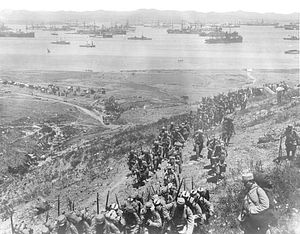A few curated defense and security links to start your week:
Last week marked the centennial of the start of the devastating Gallipoli Campaign, a World War I offensive that saw the Allied powers land on the Gallipoli peninsula to attack the Ottoman Empire. The campaign was a miserable failure for the allies, but a major victory for the Ottomans. April 25 is recalled as ANZAC day in Australia and New Zealand, commemorating the military casualties suffered by Australian and New Zealand troops. Accompanying the ANZAC Corps were 15,000 Indian soldiers, 1,400 of whom died at Gallipoli. ABC’s Stephanie March recalls the contribution of these Indian troops on the Gallipoli Campaign and their camaraderie with the ANZAC Corps.
Writing for Commentary Magazine, Michael Auslin argues that the new U.S.-Japan defense guidelines will represent a sea change for Japanese defense policies. The guidelines are nearly finalized and take into consideration recent changes in Japan’s defense posture, including the Abe government’s reinterpretation of a constitutional clause allowing for the country’s armed forces to participate in collective self-defense for the first time.
I recently discussed a Wall Street Journal article that cited growing concern among Chinese nuclear experts about North Korea’s nuclear weapons program. Siegfried Hecker, a U.S. expert, cited in that article has an interview up courtesy of Stanford’s Center for International Security and Cooperation where he discusses that report (in which he is quoted), and the broader context and significance of what Chinese experts believe about North Korea’s abilities and intentions. Notably, the Journal’s report noted that Chinese experts expected North Korea could add around 10 uranium bombs over the course of a year. In his interview, Hecker notes that “Pyongyang’s move to augment their limited plutonium production in the 5 MW-electric reactor (at most one bomb’s worth of plutonium per year) with enriched uranium changed the game.”
Japanese police arrested a man who managed to fly a small drone carrying “trace amounts of radioactive material” onto the roof of Japanese Prime Minister Shinzo Abe’s home. The stunt was primarily intended to protest the Japanese government’s nuclear policy. Abe wasn’t home at the time—he was in Indonesia for the Asia-Africa Summit.
Max Abrahms, a terrorism expert and political scientist at Northeastern University, has a must-read piece up on predicting the behavior of terrorist groups over at Political Violence @ a Glance. Abrahms takes a crack at what he calls the “Puzzle of Terrorism: If attacking civilians only encourages governments to dig in their political heels, why do groups do it?”
Next week marks the 40th anniversary of the fall of Saigon, the event that marked the end of the Vietnam War after the Viet Cong captured Saigon, the capital of South Vietnam. Over at the Brookings Institution, two authors reflect on the legacy of the Vietnam War in the context of Southeast Asia.
My colleague Franz-Stefan Gady has a thoughtful piece up over on Asia Defense where he tells you what no other geeky defense analyst will dare discuss: the violent killing of human beings.

































